An optical fiber signal repeater, also known as a core component of a distributed antenna system (DAS), is an advanced communication device that utilizes fiber optic networks to transmit radio frequency (RF) signals.
Working principle
Optical fiber signal repeater working principle is to convert RF signals into optical signals, transmit them over long distances and with low loss through optical fibers, and then convert the optical signals back into RF signals, thereby expanding the coverage range of wireless communication and improving signal quality.
The working principle of fiber optic signal repeater is based on photoelectric conversion technology, which realizes the mutual conversion between wireless radio frequency (RF) signals and optical signals, thereby achieving effective signal amplification and long-distance transmission. The workflow mainly includes the following steps:
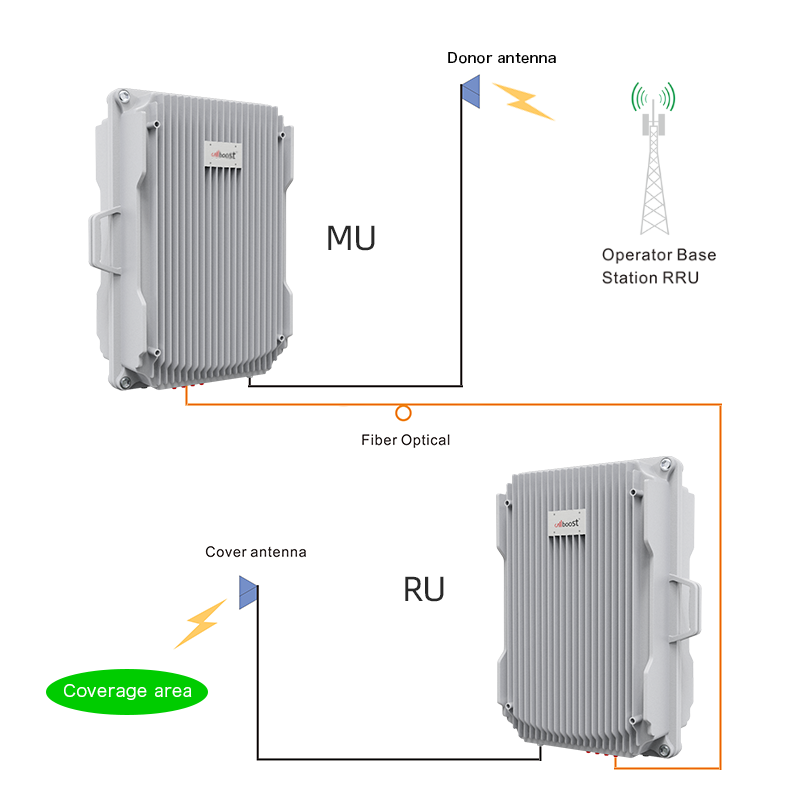
1.RF signal capture and preprocessing: The Remote Unit (RU) of the fiber optic signal repeater captures the wireless RF signal transmitted by the base station. This part is usually located near areas with weak signals or areas that require enhanced coverage, such as inside buildings or geographical blind spots.
2.RF to optical signal conversion: The captured RF signal is then converted into an optical signal within the RU through an RF/optical converter. This process involves down converting the frequency of the RF signal to the optical frequency band, while adjusting the power to ensure that the signal quality and strength meet the requirements of fiber optic transmission.
3.Optical signal transmission: Optical signals are transmitted along fiber optic cables to their destination. Due to the low loss and high bandwidth characteristics of optical fibers, they can maintain signal strength and greatly reduce attenuation and interference during transmission, achieving efficient long-distance transmission.
4.Optical signal decoding and RF recovery: At the target location, the RU at the other end converts the received optical signal back into an RF signal. What is being done here is reverse conversion, which means restoring the optical signal to RF format for further processing and broadcasting.
5.RF signal amplification and retransmission: The converted RF signal will be amplified in the RU, and if necessary, frequency adjustment and filtering processing will be performed. Then, it will be emitted through built-in small antennas or distributed antenna arrays to achieve final signal coverage enhancement.
Bidirectional communication support: The same process applies to the reverse link, which is the signal transmission path from the user side to the base station. The signals emitted by mobile phones and other terminals are collected, converted, and returned to the base station through the same process, completing the complete communication cycle.
What the necessary conditions are required a fiber optic signal repeater?
Fiber optic signal repeater, due to its unique high-performance characteristics, demonstrates its importance and irreplaceability under the following specific conditions:
1.Geographic obstacle obstruction: When natural terrain (hills, forests), man-made structures (high-rise buildings, tunnels), or building materials (concrete, metal) obstruct wireless signals from effectively penetrating or covering, fiber optic repeater can bypass the obstacles through fiber optic cables to ensure signal continuity.
2.Large scale coverage requirements: Large facilities such as sports venues, shopping malls, airports, and vast suburban or rural areas require wide coverage and high-quality wireless networks. Fiber optic signal repeater stations can ensure uniform signal distribution and meet the communication needs of high-density populations.
3.High data throughput: In data intensive locations such as data centers, high-tech parks, etc., fiber optic signal repeater stations provide high bandwidth to support large traffic transmission, meeting large-scale data exchange and high-speed services.
4.Professional communication requirements: Medical, military, aerospace and other fields have strict standards for the reliability and confidentiality of communication, and the excellent performance of fiber optic repeater stations ensures the smooth completion of key tasks.
5.Disaster recovery and emergency response: After natural disasters such as earthquakes and hurricanes, fiber optic repeater stations can quickly rebuild communication bridges, providing timely communication channels for rescue personnel and affected people.
6.Mobile network blind spot filling: For signal weak areas outside of urban hotspots, fiber optic repeater stations are used as temporary or permanent solutions to fill network coverage gaps.
7.Transportation industry: Fiber optic signal repeater serves passengers and staff on ships and airplanes at sea and in the air, ensuring uninterrupted communication experience along the way.
8.New community and development projects: With the development of the city, fiber optic repeater stations are pre arranged in the early planning stages of emerging residential and business districts to avoid signal difficulties caused by structural limitations in the future.
9.Renovation of old buildings: In the historical protected area, with a harmonious appearance and integration of the original architectural style, a fiber optic repeater is installed invisibly to solve internal signal problems.
10.Temporary requirements for specific events: such as concerts, exhibitions, and other short-term high traffic events, temporary installation of fiber optic repeater stations to enhance on-site communication capabilities.
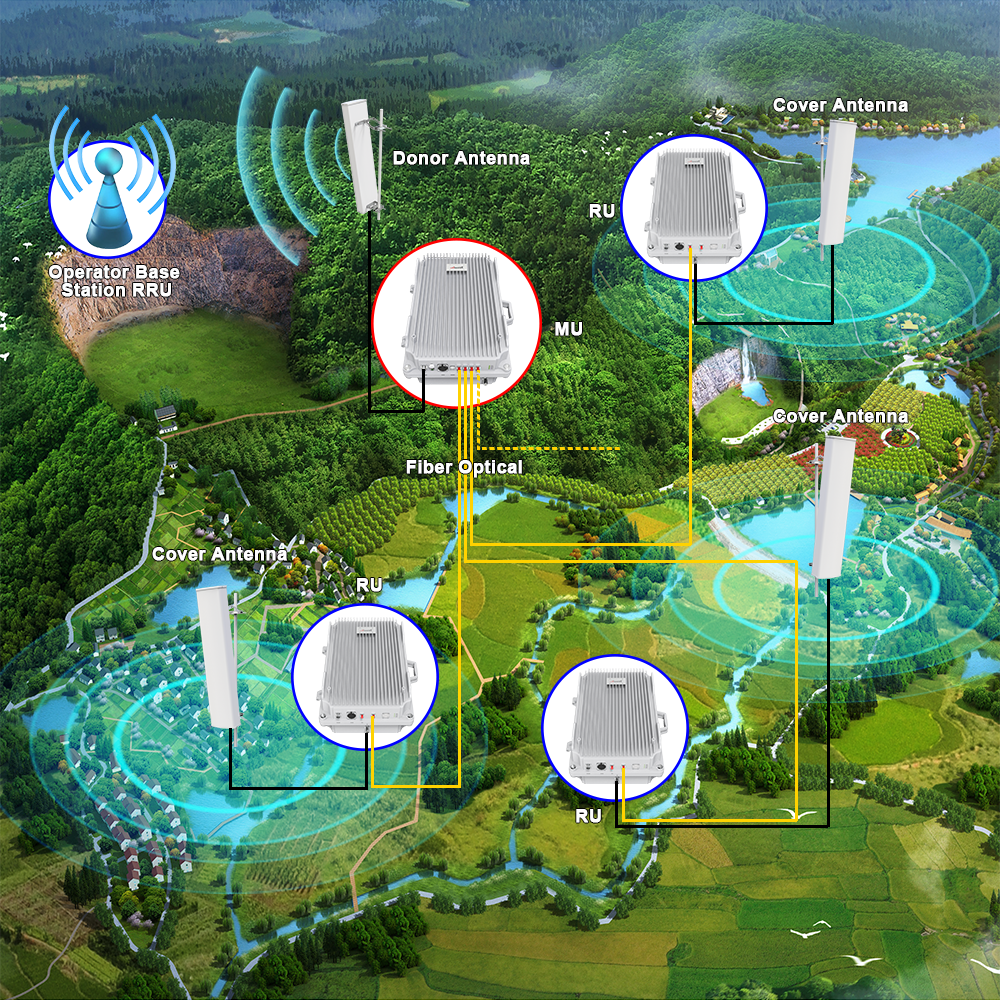
In short, fiber optic signal repeater can play a key role in any environment with stable, continuous, and high-quality wireless communication requirements. Through its efficient and flexible solutions, it breaks through geographical, technological, and human barriers and becomes a key link in building a comprehensive and three-dimensional communication network.
Application scenarios of fiber optic signal repeater
Fiber optic signal repeater, as a new generation of wireless signal enhancement technology, exhibits significant advantages in various aspects compared to traditional RF repeater, especially suitable for large-scale and high demand communication scenarios. The following is a detailed description of its core advantages:
1.Ultra long transmission distance: The low attenuation characteristics provided by fiber optic media enable signals to span several kilometers without significant attenuation, significantly improving the coverage range of wireless networks, especially suitable for distributed communication needs in vast areas or high-rise buildings.
2.High signal fidelity: Fiber optic transmission hardly introduces additional noise and distortion, ensuring signal purity and integrity, and maintaining communication quality even in harsh electromagnetic environments.
3.High bandwidth carrying capacity: The large transmission bandwidth of optical fibers provides a solid foundation for real-time delivery of high data rates and multimedia services, meeting the bandwidth requirements of current and future technologies such as 5G and the Internet of Things.
4.Strong environmental adaptability: Fiber optic materials themselves are not affected by electromagnetic interference, which means they can still work stably under extreme conditions such as high voltage power fields and frequent lightning activities, greatly enhancing the reliability of the system.
5.Easy expansion and management: adopting modular design, it is convenient to add or remove nodes as needed, achieving elastic adjustment of network coverage area; The central control system can remotely monitor and diagnose faults at various nodes, simplifying operation and maintenance.
6.Physical security: Unlike radio frequency signals, optical signals in optical fibers are difficult to capture or eavesdrop on, which enhances the security and confidentiality level of communication content.
7.Green and environmentally friendly: Fiber optic repeater has low overall energy consumption, no electromagnetic radiation, and conforms to the concept of sustainable development, which is conducive to creating a green communication environment.
8.Overall cost-effectiveness: Although the initial investment may be high, in the long run, fiber optic repeater stations can achieve higher cost-effectiveness throughout their lifecycle due to their durability, low maintenance costs, and flexible expansion capabilities.
9.Multi functional integration: In addition to wireless communication, the same fiber optic network can also be used for data transmission, video surveillance, and other service integration, improving resource utilization.
10.Wide compatibility: Good compatibility with existing communication standards, supporting multiple wireless technologies and services such as GSM, CDMA, WLAN, LTE/5G, etc., providing users with comprehensive communication solutions.
In short, fiber optic signal repeater, with its unique advantages, is gradually changing our understanding of traditional wireless signal enhancement methods and becoming an important cornerstone for building a powerful, reliable, and efficient new generation communication infrastructure. Fiber optic repeater is an attractive choice for both meeting current demands and looking forward to future challenges.
Callboost fiber optic signal repeater
We adopts software radio technology in CR90F,CR95F series fiber optic signal repeater.
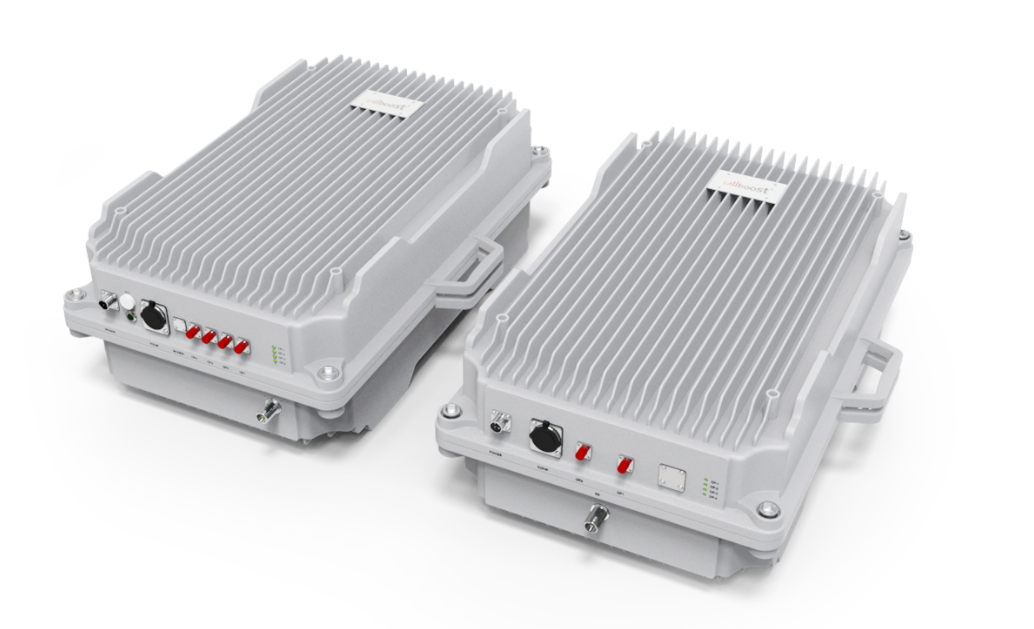
The CR90F-MU,CR95F-MU (main unit) has 4 LC optical ports, which can be connected to 4 RU(remote unit). The RU is also equipped with 2 FC optical ports, which supports parallel or series connection of multiple RU. The transmission distance between the MU and the RU is up to 15km, which is suitable for 2G 3G 4G signal coverage in villages, tunnels, mines and other places.
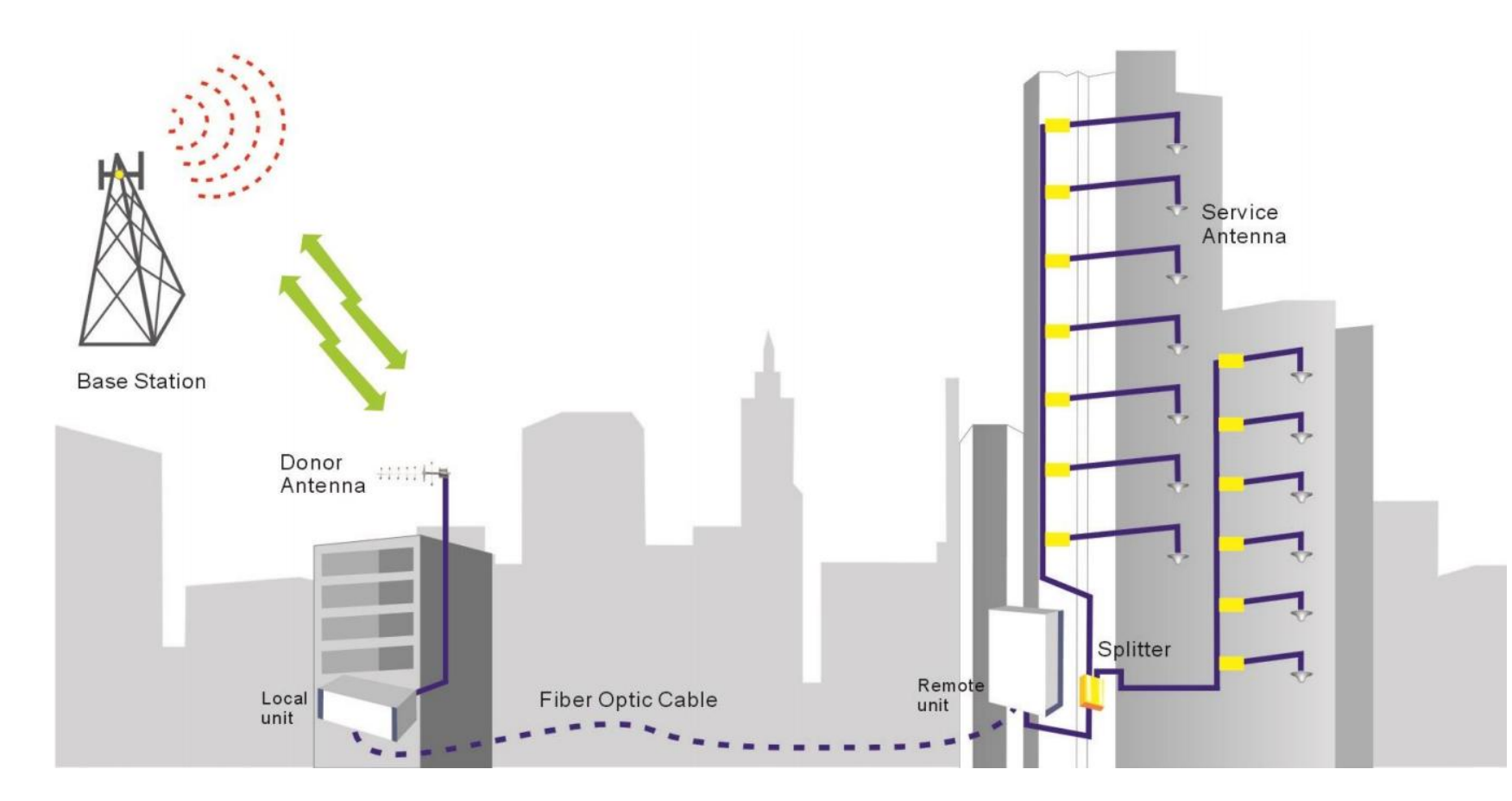
Also,we can provide Wireless Signal DAS MDAS Solution.
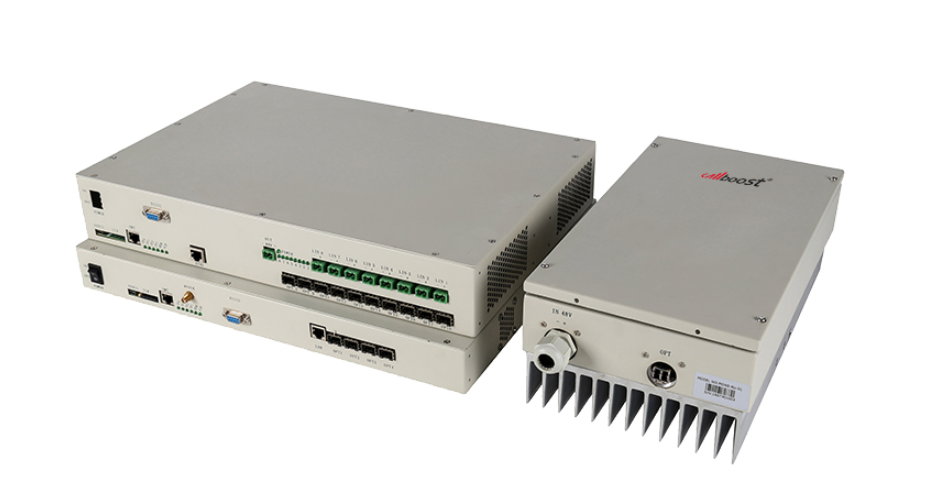
MDAS solutions is one of in-building distribution antenna system for indoor signal enhancement solutions. This solutions are widely used for the big area such airports,stations, hotels as this solution one main unit could link four entended unit, and one entended unit could link four remote unit, the maxinum could link 256 remote units. It's the best choice for large area mobile signal improvement.
